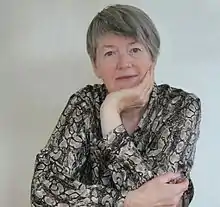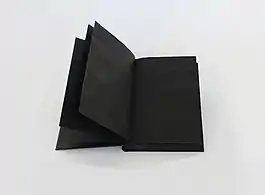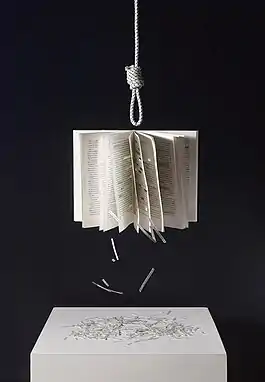Marie Hanlon
Marie Hanlon is a Dublin-based Irish artist working in a variety of media including painting, drawing, sculpture, video and installation. She has collaborated with Irish composers, most notably Rhona Clarke, in creating works which can be realised in both concert performance and gallery situations.
Marie Hanlon | |
|---|---|
 Portrait of Marie Hanlon | |
| Born | 20 December 1948 Goresbridge, County Kilkenny, Ireland |
| Nationality | Irish |
| Education | University College Dublin, National College of Art and Design |
| Notable work | It’s all About Books (2019), DIC TAT (2014), Everything we see… (2014) |
| Website | https://www.mariehanlon.com/ |
Hanlon received her early education from the Brigidine Sisters, Goresbridge, County Kilkenny and later graduated from University College, Dublin (1977) with a BA in English and History of European Painting. In 2018 she received an MA from The National College of Art & Design, Dublin. Hanlon was elected to Aosdána in 2015; Aosdána is the cultural body which recognises major and sustained contribution to the arts in Ireland.
Artistic practice


In 1988, Hanlon became a member of WAAG – Women Artists Action Group (1987–1991). She exhibited with the group in their first and only show in Ireland, Art Beyond Barriers at the Irish Museum of Modern Art in 1989 (Cummins, 1989).[1] Hanlon's first solo show was in Temple Bar Gallery in 1993. By now her works had begun to demonstrate a stylistic approach, which is simultaneously geometric and lyrical, their reduced elements tautly balanced and “characteristically subtle in the handling of tone, texture and composition.” (Finlay, 1997)[2] “The paintings are like poems or pieces of music, at once tentative and sensual, yet highly structured.” (Benson, 2004)[3]
“Forms are repeated in the paintings but rarely in exactly the same way. It is the repetition which gives the work its rhythm, a kind of pulse is established by stating and restating the idea. However, as soon as a pattern is set up it is quickly subverted and transformed, the beat changes as it were, giving the work greater complexity and interest.” (Clarke, 2009)[4]
Critic Gavin Weston has described “works that are paradoxically structurally contained yet emotionally expansive.” (Weston, 2004)[5]
Collaborations and recent work
Affinities with music in Hanlon’s work led to new developments and an expanded practice. Two significant exhibitions in 2014 involved collaborations with several contemporary Irish composers; Everything we see… at Solstice Arts Centre (2014) included works made with composers, Grainne Mulvey, Jane O’ Leary, Rhona Clarke and Emma O’Halloran. The show occupied all three of Solstice’s upper galleries and in the foyer, an installation of thirty-eight drawings further explored links between music and line. Mary Cremin observes ‘The mark-making of notation [musical] and its relationship to drawing is the beginning of exchange between composer and artist’.[6]
DIC TAT at Draíocht Centre for the Arts (2014) was a two-person show by Hanlon and composer Rhona Clarke. In this exhibition, a metronome provided basic pulse material from which sound and visual elements were derived. A group of drawings ‘dictated’ by various metronome beats were documented in real-time and shown on a two-channel video. ‘The narrow margin of space for deliberation remains confined to the intervals between beats.’ Rowan Sexton[7]
A further development of Hanlon’s collaborative practice is video for live performance; Richard O’Donnell and The Royal Irish Academy Percussion Ensemble commissioned Behind closed Doors (2016) for the Tambourimba Percussion Festival, Cali, Colombia; music by Rhona Clarke, video Marie Hanlon. In 2019 accordionist Dermot Dunne played live to a screening of The Small Hours (2019) Shatin Town Hall, Hong Kong, music Rhona Clarke, video Marie Hanlon.
Hanlon’s exhibition (2019) It’s All About Books, The Cregan Library, Dublin City University, explored the book as art object, Irish Times critic Aidan Dunne wrote ‘’Even when her approach is playful, as it often is, what we see is imbued with what might be described as a threat of nullity, the disappearance or cancellation of meaning.’[8][9]
‘It's All About Books manifests the artists ongoing exploration of the 'complexities of seeing', inviting viewers to variously consider: What kind of seeing occurs when we read.’ Material Knowledge: The Book as Artistic Device, Joanne Laws, It’s All About Books, 2019.[10]
References
- Cummins, Pauline, ed. (1989). WAAG: Art Beyond Barriers. Dublin, Ireland: WAAG Publications.
- Finlay, Sarah (1997). Landscape & Recollection: The Ballinglen Experience. Dublin: RHA Gallery Trus. pp. 36–37. ISBN 1902168003.
- Benson, Ciarán (2004). In the Time of Shaking. Dublin: Art for Amnesty. ISBN 9780954725808.
- Clarke, Rhona (2009). Éigse. Carlow: Éigse Carlow Arts Festival.
- Weston, Gavin (Spring 2004). "Belfast: Colourchart at Ormeau Baths and John Kingerlee at Taylor Gallery". Circa (107). Retrieved 8 November 2015.
- Cremlin, Mary (2015). Other Realities: Everything We See…. Solstice Art Centre.
- Sexton, Rowan (2014). tête-à-tête, DIC TAT. The Rubicon Gallery. ISBN 978-0-9565453-1-2.
- Dunne, Aidan. "Blank pages, black books and a Ulysses that's hard to get into". The Irish Times. Retrieved 13 October 2020.
- Rory O’Byrne; Sarah O’Neill; Caroline Crowley. Not in Alphabetical Order. ISBN 978-1-9999-7384-1.
- Laws, Joanne (2019). Material Knowledge: The Book as Artistic Device, It’s All About Books. pp. 29–31. ISBN 978-1-873769-92-8.